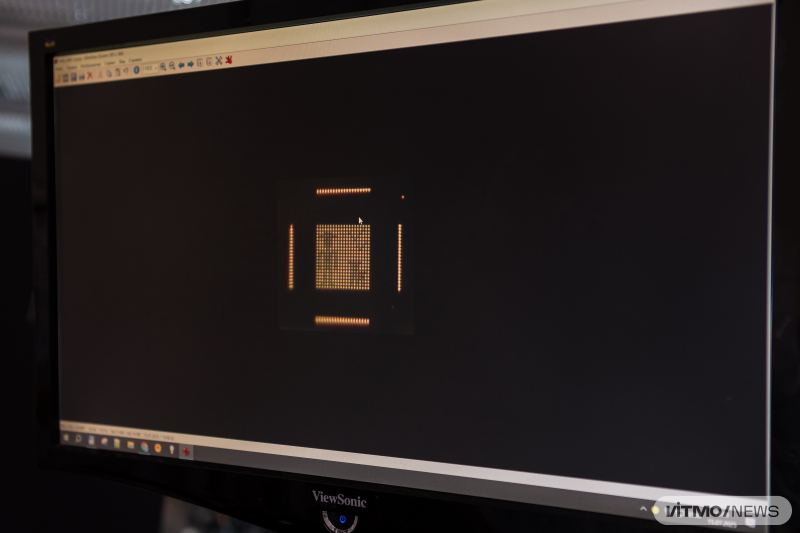Researchers from ITMO’s School of Physics and Engineering have developed optical labels made with gold and silicon. The nanostructures’ asymmetric shape determines their optical response to a specific direction of light: the tags become visible and change color from yellow to green only at a certain angle (57-75 degrees) of lateral lighting, while no effect is observed at other angles. This solution will find its applications in the authentication of optical chips, sensors, and other microelectronics. The corresponding paper was in ACS Applied Optical Materials.

The new anti-forgery tags. Photo by Dmitry Grigoryev / ITMO NEWS
Various products are protected from forgery by different means – including unique holograms or QR and bar codes. Even though these are convenient in mass production, they are also easy to forge with the necessary equipment. In their search for more secure solutions, researchers are looking into promising security technologies based on the optical properties of nanostructures. Of particular interest in this regard are tags whose protective properties revolve around their interaction with specific types of lighting. Scientists use light scattering as the observable protective property. Its efficiency can be managed by selecting the optimal size, shape, and materials of nanostructures, as well as the parameters of external excitation, such as the angle and polarization of light. However, the exact “recipe” for precise control of light is known only for nanostructures made from one material and not two.
Physicists from ITMO’s School of Physics and Engineering have demonstrated how light scattering is modulated by polarization in hybrid gold-silicon nanostructures – their shape resembles microscopic mushrooms, with a silicon “stem” and a gold “cap.” The interaction of the incident electromagnetic field with the mushroom-shaped nanostructures induces bianisotropy – a state in which the nanostructure simultaneously responds to both the electric and magnetic fields of light. The resulting tag demonstrates unique optical properties: it is capable of changing color only when lit at angles of 57 to 75 degrees. This study was conducted by the under the supervision of Dmitry Zuev, a leading researcher of ITMO’s School of Physics and Engineering, and with support from Alferov University of the Russian Academy of Sciences.

Pavel Kustov setting up the installation used to study the polarization dependence in nanostructures. Photo by Dmitry Grigoryev / ITMO NEWS
“Using a lithography machine, we created the hybrid gold-silicon nanostructures and modified some of them with a femtosecond laser. Next, we analyzed the sample in dark field geometry using different linear polarizations of the incident radiation at a 70-degree angle. It turned out that when the vector of the electric field is in the plane of the incident light, the original and modified nanostructures have an identical yellow coloring. However, when the vector of the electric field is at a right angle to the incident plane, the original nanostructures remain yellow, while the modified ones turn green. This effect can be used to create tags that will be visible only from a specific angle,” explains Pavel Kustov, the paper’s first author and a junior researcher at ITMO’s Faculty of Physics.

A demo of the tag. The original and modified nanostructures are colored in identical yellow. When the polarizer rotates, the original structures remain yellow, while the modified ones turn green. Animation courtesy of Pavel Kustov
As special equipment is required to produce the tags, this will be an additional barrier against forgery. The tags can be read both manually and using a computer vision algorithm developed by ITMO researchers for this purpose. Importantly, this reading can only be accomplished at a specific setting of the optical installation, i.e. when the lateral lighting is positioned at the necessary angle. In this case, the algorithm will verify the tag based on an international colorimetry standard () as issued by the International Commission on Illumination.
As an example, the team created an image of a human and a dog just 20*20 micrometers in scale. The image’s parameters and contents can be changed as required. Moreover, the tags are easily scalable, meaning that they can easily be adapted for mass production of optical chips, sensors, and other microelectronics.
In the future, the researchers are planning to determine if the identified effect can be observed in simpler systems. For this, they will experiment with asymmetric nanostructures consisting of a single material and study their behavior in different modifications.
